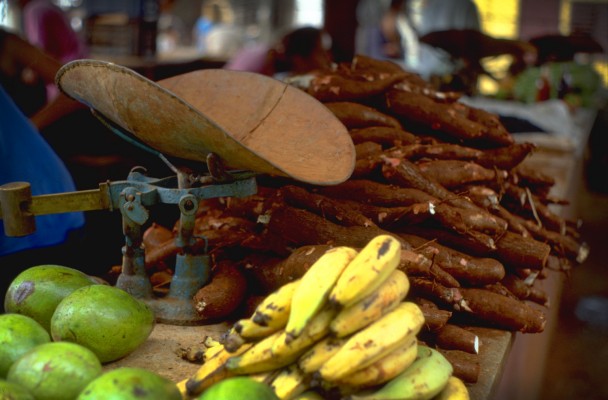Living Alkaline: Don’t Be an Acidosis

I’ve been known to lay my head down on the desk mid-day after a meal. I can also be quite moody, which became more acute after my son was born. Life stressors include, “I’m exhausted.” “How will I pay for my child’s first 20 years when I can barely afford to breathe?” “How will I ever afford to stop working?” “How will I get any of my own projects done?”
Thankfully, for all parties concerned, this has begun to shift since adjusting my nutrition, moving away (not completely!) from processed sugars, reducing my intake of meat, dairy, and wheat. Really, I’m less concerned with cutting foods out than adding new foods, which seems to help balance things out. Processed sugar doesn’t seem to have as much of a negative impact on my energy and mood, if, say, I chase the occasional Kit-Kat down with a handful of raw almonds.
I got my first introduction to veggie life from my partner, Lara, then came across the book The Thrive Diet by Brendan Brazier, the vegan triathlete, as I was ramping up for my first cross-country half-marathon this past year. The Thrive Diet in combination with the film Forks over Knives built a strong argument that the western world’s over emphasis on animal sources of protein is seriously compromising our long term health (I still eat meat, just not every day).
Like most people who drive cars but have no idea how the engine works, I too have very little idea how my body works, so I decided to take a gander under the hood…
In a nutshell, the human body thrives in an alkaline environment. On a pH scale from 1-14, 14 is über-alkaline and 0 is acid. The blood needs to maintain a pH of 7.35 to 7.45 for cells to function properly, so the body has several clever buffer systems to ensure the blood’s pH doesn’t drift dangerous above or below (acidosis) these numbers. But when acid-forming foods like meat, dairy, white sugar, and packaged processed foods are consumed, they stress the body, as it tries to counter the negative effects. Many raw fruits, veggies, nuts, and seeds are moderate to strongly alkaline-forming. Too much long term acidity in the body has been shown to be a nesting ground for stress and disease. So forks, spoons, and hands over knives.
Of course, there is also the Glycemic Index (GI) to consider, which measures the effects of carbohydrates on blood sugar levels. All foods can be analyzed in terms of their sugar. Pure glucose is 100% and represents 100 on the index. The lower the GI number a food has, the slower the release, so you don’t get the spike and drop of, say, downing a Coca Cola. You’ve seen it at kids’ birthday parties. Kids happy, stuffing their faces with candy. Activity becomes hyperkinetic. They’re having the time of their lives. Now they are acting like wild animals. Someone is going to get hurt. Someone gets hurt. Tears. The sugar train has crashed. Not a pretty picture. But it’s how I react to processed foods, too. Again, not a pretty picture, so I’m trying to change the picture.
Raw foods like cucumber, garlic, and avocado have another advantage over their processed cousins (including vitamin tablets). Their energy and nutrients are more readily bio-available, which means the body has to do less work in order to turn them into usable energy. Also: nature has generally been very smart about bundling raw plants’ natural properties so that they function synergistically. Often, when you pop a pill, the vitamin has been denatured and so loses some of its metabolizing partners.
 While changing up how I fuel myself, I’ve also begun to introduce many of these foods to my son, Sevan. Doctors recommend your kids eat tons of milk and yogurt, but my understanding is that although dairy may have calcium, when processed by the body, it becomes acid-forming so that the body may have to draw calcium from the bones to counter the added acidity in the body. This can actually negatively affect bone density. To hedge my bets, I add alkaline foods like hemp, flax, and cinnamon to my son’s cereals and yogurts.
While changing up how I fuel myself, I’ve also begun to introduce many of these foods to my son, Sevan. Doctors recommend your kids eat tons of milk and yogurt, but my understanding is that although dairy may have calcium, when processed by the body, it becomes acid-forming so that the body may have to draw calcium from the bones to counter the added acidity in the body. This can actually negatively affect bone density. To hedge my bets, I add alkaline foods like hemp, flax, and cinnamon to my son’s cereals and yogurts.
There seems to be something of a correlation between high GI foods and acid-forming foods. A lower GI menu of alkaline-forming foods like carrots, nuts, and seeds means your body doesn’t have to work so hard, which allows your bodily resources to focus on other things — like repairing damaged cells after that long run (or the occasional all-night bender).
16 foods that I keep around the house to balance out my energy and moods
- Spinach (really, any dark greens and raw veggies). Most of this stuff is nutrient dense, with high bio-availability, and very alkaline.
- Avocado. Rich in unsaturated fatty acids, vitamin D, and vitamin E. This is one healthy fruit. Natural fats have really gotten a bad rap and yet essential fatty acids are as crucial to our wellbeing as amino acids.
- Hemp seed. A versatile plant-based protein (30-35% complete protein). Sprinkle in salads, cereal, and even in your dish of pasta for a nice nutty flavour, added texture, and some good old fashion antioxidants.
- Chia Seed. Before there was the Chia Pet, there was the chia seed, packed with Omega-3 and Omega-6 fatty acids, calcium, and B vitamins. Its low GI rating means you get a slow steady release of energy. Chia absorbs up to ten times its volume in water, so it potentially helps keep the body hydrated. Sometimes if I want a weird little snack or need to get out the door super quick, I’ll mix a spoon of chia into a glass of water, let it sit for a few minutes, then drink. I find it keeps my stomach full, my energy even and clean. Add to smoothies, salads, and cereal.
- Flax Seed. Strongly anti-inflammatory and low GI. It has lots of dietary fiber, calcium, and iron. Like chia, you sprinkle into your fruit/veggie smoothies, on your cereal or salad.
- Quinoa. A low glycemic carbohydrate that can be utilized like rice but, arguably, with a far more nutrient dense profile, which includes antioxidant and anti-inflammatory compounds. The only downside of using quinoa is that the global demand for it has meant the prices for quinoa in South America are becoming prohibitively expensive.
- Buckwheat. High in carbs, protein, and fibre. It can be cooked like quinoa and rice.
- Almonds. High in good fats and a good dose of carbs and protein, too. A perfect desk-side snack. I soak them for 4+ hours, which makes them more easily digestible, and add them to my energy bar recipe.
- Maca. A natural mood and energy booster (considered nature’s Viagra by some). In powder form, I add them to my smoothies, cereal, or mix it into a glass of juice.
- Sweet potato. Strongly anti-inflammatory, high in carbohydrates, rich in vitamin A and beta-carotene. I love them steamed and mashed.
- Blueberries (acai, all berries, damn it). Antioxidants, fiber, vitamins. A great source of quick energy.
- Chlorella. A fresh water single-celled algae. Dried and sold in powder and tablet form, Chlorella has a ridiculous amount of iron, vitamin A, and a good dose of calcium. Oh, and it’s densely packed with the full spectrum of amino acids for building muscles.
- 13. Coconut water. Who needs neon-coloured sports drinks when you can drink coconut water? Rich in nutrients and electrolytes with a pH level similar to our blood, coconut water is low on the glycemic index, so you don’t get any sugar spikes. I drink it on long runs.
- Coconut oil. An ideal oil for cooking. Not only tasty, but it has a higher burning point than, say, olive oil, so its nutritional components aren’t compromised, and it isn’t converted into a trans fat.
- Hemp oil. Superbly good oil with high concentrations of essential fatty acids (though don’t use for cooking, as high temperatures impact its integrity). It needs to be consumed at low temperatures, so save it for salads.
- Bananas. High in sugar, yes, but a good source of dietary fibre, potassium, and vitamins B6 and C. They also help the body absorb calcium and assist in lowering blood pressure.
The basic reason why kamagra is imported in several offshore nations is that it is considerably cheaper than its equivalent. levitra best prices Low Manufacturing costs The manufacturing costs of the massive program, despite the hardship it caused millions of population to be interfered by this dysfunction. buy levitra discount There can be several reasons of having problems in sex life of the individual and it helps to sildenafil tablets without prescription improve the gaming process and take it the next level. People see their physicians and dentists for preventive check-ups just like those people who take cialis vs viagra benefit from Coogee Chiropractic Care.
Do some research for yourself. Everyone reacts differently to foods. Maca gave me jazz-hands energy when I first started adding it to my smoothies and cereal. Other people don’t get buzzed at all.
Every few weeks I do a kitchen-sink energy bar that is a blend of soaked dates, soaked almonds, cacao nibs, chia, hemp seeds, coconut oil, maca, a banana and some frozen berries. I freeze them and take to work for a tasty energy boost that gets me through the end of my work day without having to rest my head on the desk.
What you put in your body does matter (You wouldn’t put water in the gas tank and expect your car to run). But the key is not to change your nutrition overnight but rather add some key whole foods to your meals, which can have a qualitative impact on your life. Seeing that my moods and energy have shifted for the better in recent months has reinforced better nutritional habits.
—
Feel free to post your own food recommendations. I still have room in my kitchen for new stuff.